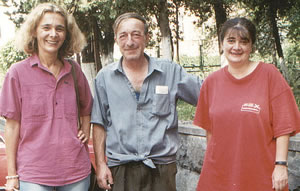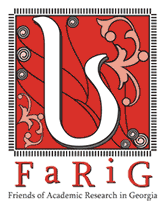Mzia Janjalia and Nana Kuprashvili
This is the first exploration of an unknown subject - the Georgian icons of the two centuries leading up to the mid-nineteeth century. Our work enabled us to understand some of the ways in which Georgian artists appropriated some western European models. Hitherto it had been the general belief that all the links came through Russia. But Georgia and Europe were far more directly connected.

![]() We, the two authors, belong to a group called "Betania". Its aim is to apply scientific methods to the restoration of paintings. We have received great encouragement from our links with the Courtauld Institute in London. "Betania" is a village to the south of Tbilisi, where at one stage the group restored the church paintings.
We, the two authors, belong to a group called "Betania". Its aim is to apply scientific methods to the restoration of paintings. We have received great encouragement from our links with the Courtauld Institute in London. "Betania" is a village to the south of Tbilisi, where at one stage the group restored the church paintings.
First of all, in July and August 2001, we did field-work in western Georgia, where we examined 136 icons. Our examination consisted in documentation, taking photographs, and collecting samples of the paint for chemical analysis. In July and August 2002 we examined 64 icons in Kartli and Kakheti. Incidentally, while examining the icons, we discovered a hitherto unrecorded reliquary in Gelati which had not hitherto been recorded, and, in Ananuri, an icon painted by Nikoloz Apkhazi. The icon had been recorded in documents, but this is the first time it has been identified. We also took the opportunity of training an assistant, Teimuraz Gotsadze, a student at the Courtauld Institute.
![]() In between the field work we studied in the State Archive of Georgia and the archive of the Exarchate and Synod. We studied engravings - Georgian, Russian and European - in the National Library. A number of additional icons were found in the State Museum.
In between the field work we studied in the State Archive of Georgia and the archive of the Exarchate and Synod. We studied engravings - Georgian, Russian and European - in the National Library. A number of additional icons were found in the State Museum.
Due to our work we have identified for the first time the main stages in the period of painting between 1600 and the mid-nineteenth century. A summary follows:
Main Influence
The main influence was the adaptation of European engravings, including Italian, French, Dutch, and German of the 15th-17th centuries. Indeed in the State Library, we saw parts of the English illustrated Bible, which Prince Ioane Bagrationi wanted to serve as an example to be followed by Georgian artists. The influence of western Europe was also channelled through the Catholic Missions in Georgia. Historical documents speak of paintings, books, and engravings being brought to Georgia, and describe the painting of several churches and icons on panels. They also record the reactions of Georgian society to these paintings.
The Evidence
![]() The wide introduction of European art started in the seventeenth century in Georgia. The art of that period includes wall paintings and manuscript illuminations, but the same tendencies can be seen in icon painting. For the 18th century the main source is icon painting. Georgian literature of this period also retains less and less medieval thought-processes. Examples of this for the seventeenth and eighteenth centuries there are examples from the saints lives of the Davit Gareji Desert School, with its enhancement of empirical details. For the eighteenth century the Princely Lyrics show a growing interest in secular elements.
The wide introduction of European art started in the seventeenth century in Georgia. The art of that period includes wall paintings and manuscript illuminations, but the same tendencies can be seen in icon painting. For the 18th century the main source is icon painting. Georgian literature of this period also retains less and less medieval thought-processes. Examples of this for the seventeenth and eighteenth centuries there are examples from the saints lives of the Davit Gareji Desert School, with its enhancement of empirical details. For the eighteenth century the Princely Lyrics show a growing interest in secular elements.
Change in Style
Until about 1720 the artists did not question the medieval approach to the concrete details of landscape and interior. Tempera and panel icons of still continue in the old way, and the iconostasis at Katskhi follows a Russian programme, and that at Mghvimevi follows one which is Greek. But after about 1720 they attended more and more to western European models. European engravings provided direct models. Iconostases have original programmes, mainly representing Passions, from about 1750 to 1850. Additionally they have a new notion of structure and design, an idea close to the secular carved woodwork of the time, with a mixture of Oriental and Western patterns. Long before 1850 Georgia and the Georgian Church were under Russian rule, and the new Georgian iconostases did not develop. New iconostases followed the Russian Neo-classical style.
The Turning Point
We have discovered that the turn towards European models took place between 1720 and 1740. That is the time when the engravings of the Piscator Bible, famous in the East Christian countries, can be clearly identified in the 'baroque' scenes in Georgian manuscripts and embroideries. The same influence is seen in the late eighteenth century passion icons of Gelati, Kareli Dirbi, Ruisi and Urbnisi.
It is also interesting that the technique of these icons is oil on the canvas. It is either mixed tempera or oil. 'Pure European' oil technique was introduced in Georgia by the Catholic missionaries in the seventeeth century. The technique was adopted by Georgian artists during the 18th century, and a several East Georgian icons executed in oil, and dating back to that time, are masterpieces.
A Georgian Approach
![]() From 1760 to 1770 the artists of Georgian icons were masters of 60-70- European standards of art. But they essentially transformed them, as appears by a comparison with their direct European models and with the Italian icons painted in Georgia by Catholic missioners for the King Erekle. Georgian paintings based on European engravings still express the medieval sense of time and space: the figures are static and the space in which they exist is very limited, and parallel to the surface. At a first glance the representations are very unlike the traditional medieval icons, but in comparison with European art they still have an Orthodox approach. The same features continue up to about 1830, but later on in the nineteenth century Georgian artists are influenced by Russian icon painting.
From 1760 to 1770 the artists of Georgian icons were masters of 60-70- European standards of art. But they essentially transformed them, as appears by a comparison with their direct European models and with the Italian icons painted in Georgia by Catholic missioners for the King Erekle. Georgian paintings based on European engravings still express the medieval sense of time and space: the figures are static and the space in which they exist is very limited, and parallel to the surface. At a first glance the representations are very unlike the traditional medieval icons, but in comparison with European art they still have an Orthodox approach. The same features continue up to about 1830, but later on in the nineteenth century Georgian artists are influenced by Russian icon painting.
The Workshops
Georgia has for centuries endured hard times. Thus the number of documents and inscriptions is very small, and in order to visualise the historical facts we have had to rely mainly on our analysis of the paintings themselves.. Based on the material which has been examined, we have identified some artistic workshops.
Though their links also seem undoubtable: Some of the icons of Western Georgia can be connected with Eastern Georgia. The Gelati iconostasis and templon with its inscriptions (and the illuminated manuscript by Zakaria Gabashvili) in the west, can be firmly connected with the icons from Ruisi and Urbnisi in the east, which are now kept in the State Museum of Fine Arts. And the reliquary at Gelati is firmly linked with the Bodbe paintings in Eastern Georgia. Also the whole of Georgia has the Passion as the main theme of the iconostasis, and shares the main stylistic changes.
We are most grateful to FaRiG for the $3000 which gave us the opportunity to do this piece of research.
